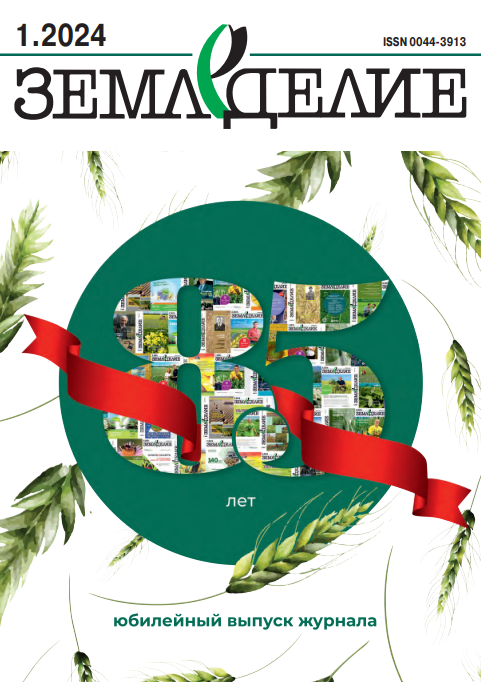Влияние пигментной системы растений различных сортов на продуктивность озимой пшеницы, возделываемой по технологии No-till
doi: 10.24411/0044-3913-2021-10302
УДК 633.11«324»:631.559 (470.630)
А. Н. ЕСАУЛКО, доктор сельскохозяйственных наук, профессор
Е. В. ПИСЬМЕННАЯ, доктор сельскохозяйственных наук, профессор
М. Ю. АЗАРОВА, аспирант (e-mail: Адрес электронной почты защищен от спам-ботов. Для просмотра адреса в вашем браузере должен быть включен Javascript.)
Ставропольский государственный аграрный университет, пер. Зоотехнический, 12, Ставрополь, 355017, Российская Федерация Исследования проводили в 2018–2020 гг. в засушливой зоне Ставрополья с целью определения влияния пигментной системы растений различных сортов озимой пшеницы на продуктивность. Почва – темно-каштановая. Предшественники (подсолнечник, нут) и сорта озимой пшеницы Зустрич (St.), Багира и Баграт возделывали по технологии No-till. Определение пигментного комплекса выполняли по методике Я. И. Милаевой и Н. П. Примак. Накопление хлорофилла а (Сa ) и хлорофилла b (Сb) в растениях по всем сортам и предшественникам с фазы кущения до трубкования увеличивалось в 0,4…1,6 и 1,07…1,2 раза соответственно, с фазы трубкования к колошению – уменьшалось в 0,9…1,06 и 0,6…0,8 раза. В 2018–2020 г. в общем фонде хлорофилла превалировал Са , соотношение Сa/b находилось в 2018 г. в пределах 0,99…2,07, в 2019 г. – 1,01…1,83, в 2020 г. – 1,06…1,84 и варьировало по сортам от 1,00 и до 2,04. Отмечали увеличение содержания каратиноидов (Скар) в растениях по всем сортам и предшественникам с фазы кущения до трубкования в 1,7…3,0 раза и уменьшения к фазе колошения в 0,94…2,0 раз. В фазе колошения Скар в 2019 г. и 2020 г. была выше, чем в 2018 г., на 0,74 мг/л. В эти годы структурные и функциональные изменения фотосинтетического аппарата растений, связанные с погодными условиями, отрицательно сказались на продуктивности посевов (по подсолнечнику она снизилась в 1,5 раза, по нуту – в 1,4 раза). Урожайность озимой пшеницы по предшественнику подсолнечник составила 2,78…4,71 т/га, нуту – 3,26…4,35 т/га. Сбор зерна сорта Багира был ниже, чем у стандарта, соответственно на 0,24 т/га и 0,71 т/га.
Ключевые слова: озимая пшеница (Triticum aestivum L.), хлорофилл, каротиноиды, продуктивность, технология No-till.
Для цитирования: Есаулко А. Н., Письменная Е. В., Азарова М. Ю. Влияние пигментной системы растений различных сортов на продуктивность озимой пшеницы, возделываемой по технологии No-till // Земледелие. 2021. № 3. С. 10–15. doi: 10.24411/0044-3913-2021-10302.
Influence of the pigment system of plants of various winter wheat varieties on their productivity when cultivated using no-till technology
А. N. Esaulko, E. V. Pis'mennaya, M. Yu. Azarova
Stavropol State Agrarian University, per. Zootekhnicheskii, 12, Stavropol’, 355017, Russian Federation
Abstract. The studies were carried out in 2018–2020 in the arid zone of the Stavropol Territory to determine the effect of the pigment system of plants of various varieties of winter wheat on their productivity. The soil was dark chestnut. The forecrops (sunflower, chickpea) and winter wheat varieties Zustrich (St.), Bagira, and Bagrat were cultivated using no-till technology. We determined the pigment complex according to the method of Milaeva and Primak. The accumulation of chlorophyll a (Ca) and chlorophyll b (Cb) in plants for all varieties and forecrops from the tillering phase to booting increased 0.4–1.6 and 1.07–1.2 times, respectively, from the booting to earing phase it decreased 0.9–1.06 and 0.6–0.8 times. In 2018–2020, Ca prevailed in the total chlorophyll pool. The Ca/b ratio was in the range of 0.99–2.07 in 2018, 1.01–1.83 in 2019, 1.06–1.84 in 2020. This ratio varied from 1.00 to 2.04 over the varieties. There was an increase in the content of carotenoids (Ccar) in plants for all varieties and forecrops from the tillering phase to booting by 1.7–3.0 times and a decrease by 0.94–2.0 times by the heading phase. In the heading phase, the Ccar in 2019 and 2020 was higher than in 2018, by 0.74 mg/L. During these years, structural and functional changes in the photosynthetic apparatus of plants associated with weather conditions adversely affected the productivity of crops (for sunflower it decreased 1.5 times, for chickpea – 1.4 times). The yield of winter wheat for the forecrop of sunflower was 2.78–4.71 t/ha, chickpea – 3.26–4.35 t/ha. The grain harvest of Bagira variety was lower than that of the standard, by 0.24 t/ha and 0.71 t/ha, respectively.
Keywords: winter wheat (Triticum aestivum L.); chlorophyll; carotenoids; productivity; no-till technology.
Author Details: А. N. Esaulko, D. Sc. (Agr.), prof.; E. V. Pis’mennaya, D. Sc. (Agr.), prof.; M. Yu. Azarova, post-graduate student (e-mail: Адрес электронной почты защищен от спам-ботов. Для просмотра адреса в вашем браузере должен быть включен Javascript.).
For citation: Esaulko АN, Pis’mennaya EV, Azarova MYu, et al. [Influence of the pigment system of plants of various winter wheat varieties on their productivity when cultivated using no-till technology ]. Zemledelie. 2021;(3):10-5. Russian. doi: 10.24411/0044-3913-2021- 10302.










